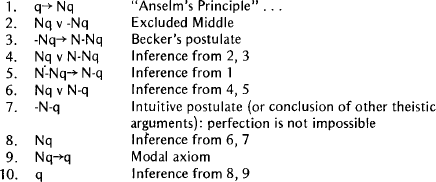No CrossRef data available.
Published online by Cambridge University Press: 01 January 2020
We wish to examine Hartshorne's ontological argument, as formulated in his discussion entitled “The Irreducibly Modal Structure of the Argument.“ The argument is as follows.

We wish to show that, if the above argument is to work, “q” (A perfect being exists“) must be analytic. If it is analytic, Hartshorne is saddled with a contradiction. Furthermore, if “q” is analytic, the argument is irrelevant. (One could take Baier's position on analyticity and argue that “q” is analytic, but tells us nothing about what, in fact, exists, but now the “proof” would not prove that a perfect being exists.)
1 This was originally Chapter 2 of Hartshorne's, The Logic of Perfection (LaSalle: Open Court Publishing Co., 1962)Google Scholar, but has been reprinted in: Hick, J. and McGill, A. C. The Many-Faced Argument (London, 1968), pp. 334–341Google Scholar. All references will be to the latter source.
2 Hick, and McGill, op. cit., pp. 335 and 348.Google Scholar
3 Baier, K. E. M. “Existence,” Proceedings of the Aristotelian Society, LXI (1960-61), 19–40.Google Scholar
4 Hick, and McGill, op. cit., p. 337.Google Scholar
5 Hartshorne's first step also presupposes that “A perfect being exists” is analytic. His justification for 1 is that, if you accept ((∃x) (Px) and (-N(∃x) (Px)) → -Px, it follows that (∃x) (Px) → N(∃x) (Px). The reason is that “ … the antecedent is necessarily false, since it both asserts and by implication denies perfection … of a supposedly contingently existing subject …” (Hick, and McGill, op. cit., p. 336)Google Scholar. In other words, “N-((∃x) (Px) and -N(∃x) (Px)” is true. But given his interpretation of “N” in Section I above, “N-(…)” will be true just in case “(…)” is self-contradictory. This can only happen when “(∃x) (Px) and (-N(∃x) (Px)” is self-contradictory, in the above case. This can be so only if “(∃x) (Px)” is equivalent to “N(∃x) (Px).” This will be so if “(∃x) (Px)” is analytic (logically true).
6 Hick, and McGill, op. cit., p. 335.Google Scholar
7 Concerning Anselm's first proof, Malcolm says (Hick, and McGill, op. cit., p. 304)Google Scholar: … Anselm's ontological proof of Proslogion II is fallacious because it rests on the false doctrine that existence is a perfection (and therefore that “existence“ is a “real predicate”…)
Concerning the second proof, Malcolm says (ibid., p. 306): … Previously I rejected existence as a perfection. Anselm is maintaining in the remarks last quoted, not that existence is a perfection, but that … necessary existence is a perfection…
Hick attributes this view to both Malcolm and Hartshorne (ibid., p. 348).
8 Hick, and McGill, op. cit., p. 309Google Scholar. The article is “Anselm's Ontological Arguments“ by Malcolm, originally published in the Philosophical Review in 1960.
9 Prior, A. N. Past, Present and Future (Oxford, 1967), p. 22.CrossRefGoogle Scholar
10 Hick, and McGill, op. cit., p. 309.Google Scholar
11 Possibly this is what Hick has in mind when he says that Hartshorne's argument involves an ambiguity revolving around “ontological” necessity (as opposed to “logical” necessity). (See Hick, John “A Critique of the ‘Second Argument',” ibid., pp. 341–356.Google Scholar) What Hick has failed to point out is that the argument using logical necessity throughout (our first interpretation above) will work, provided that “a perfect being exists” is taken to be logically true. Hartshorne's argument is valid and sound but at the price of being irrelevant, since God must already be known to exist, as a presupposition of the proof.
Hick, says, however (ibid., p. 351)Google Scholar:
… I am not accusing Hartshorne of the fallacy of equivocation in his argument as he has presented it. He states explicitly that the proof is to be understood consistently in terms of logical necessity …. So interpreted, the argument does not even have an acceptable premise from which to begin….
His justification for this is that “ … prop. 1 has no kind of self-evidence, and … does not conform to any propositional form recognized in standard logical theory” (ibid., p. 349).
This is misguided at best. Hartshorne says that “q” is to stand for the proposition “A perfect being exists.” Thus, “q” is not a variable, rather it is a constant, standing for that one proposition only. P1 is a well-formed formula within his system of modal logic, and need not be an axiom of the system-it merely must be true where “q” stands for “A perfect being exists.” We have here discussed two ways in which P1 could be true.